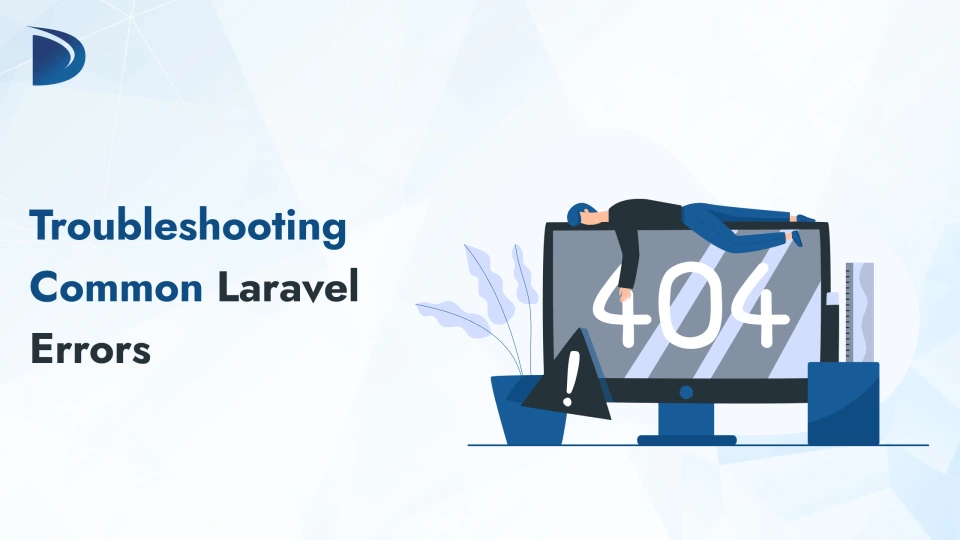Table of Contents
Laravel is a powerful and user-friendly PHP framework, but small mistakes can cause errors that slow your work. Two common issues developers encounter are Facade errors and CORS issues. Although these problems may seem unrelated, they often result from incorrect setup or missing configuration steps.
This guide explains what these errors are, why they occur, and how to fix them step by step in simple English.
Understanding and Fixing Laravel Facade Errors
What Are Laravel Facades?
Facades in Laravel make it easy to use features such as caching, logging, or authentication without writing complex code. For example, when you write Cache::get(‘key’), Laravel’s Service Container manages the underlying details behind the scenes. This keeps your code clean and simple.
However, if something goes wrong with the Service Container or class setup, you will see Facade errors.
Common Facade Errors and Their Causes
- “A facade root has not been set”
- This error means Laravel’s application isn’t fully loaded.
- Causes:
- Missing parent::setUp() in unit tests.
- The application isn’t properly booted.
- Old or broken cached configuration files.
- “Class not found”
- Laravel can’t find the Facade or the class it refers to.
- Causes:
- Missing use statement for the Facade.
- Not updating the autoloader after moving or renaming files.
- Missing Facade alias in config/app.php.
- Issues with Custom Facades
- Custom Facades fail if:
- The getFacadeAccessor() method doesn’t match the Service Provider binding.
- The Service Provider isn’t registered.
- Incorrect binding methods are used.
- Custom Facades fail if:
These are common Laravel issues when working with Facades.
Steps to Fix Facade Errors
- Add the Correct use Statement
- Always import the Facade at the top of your file. For example: php
use Illuminate\Support\Facades\Cache; - Without this, Laravel can’t find the Facade class.
- Always import the Facade at the top of your file. For example: php
- Clear Laravel Caches
- Run these commands to remove outdated or broken cache files: bash
php artisan config:clear php artisan cache:clear php artisan route:clear composer dump-autoload - These commands refresh Laravel’s system and help resolve errors.
- Run these commands to remove outdated or broken cache files: bash
- Fix Unit Test Issues
- Use Laravel’s TestCase class for tests.
- Ensure parent::setUp() is called in your test’s setUp() method.
- Check that phpunit.xml points to the correct bootstrap file (usually vendor/autoload.php).
- Check Custom Facade Setup
- Ensure the getFacadeAccessor() method returns the correct binding key.
- Verify the Service Provider is registered in config/app.php (for Laravel 10 and below) or bootstrap/providers.php (for Laravel 11+).
- Verify Aliases in config/app.php
- Make sure the Facade is listed in the aliases array in config/app.php. For example: php
'aliases' => [ 'Cache' => Illuminate\Support\Facades\Cache::class, ],
- Make sure the Facade is listed in the aliases array in config/app.php. For example: php
Best Practices for Using Facades
- Use Facades for Simple Tasks: Use Facades for quick tasks like logging or caching. For complex logic, use Dependency Injection for cleaner code.
- Stick to Laravel’s TestCase: This ensures Facades work properly in tests.
- Avoid Overusing Facades: Too many Facades in one file can make your code hard to read or test.
- Debug with dd() or Logs: Use dd($variable) or Log::info($variable) to check values while troubleshooting.
Quick Reference: Common Laravel Facades
| Facade | Class | Binding Key |
|---|---|---|
| App | Illuminate\Foundation\Application | app |
| Auth | Illuminate\Auth\AuthManager | auth |
| Cache | Illuminate\Cache\CacheManager | cache |
| DB | Illuminate\Database\DatabaseManager | db |
| Log | Illuminate\Log\LogManager | log |
| Request | Illuminate\Http\Request | request |
| Route | Illuminate\Routing\Router | router |
| Session | Illuminate\Session\SessionManager | session |
For more details, check the official Laravel documentation.
Solving Laravel CORS Issues
What Is CORS and Why Does It Matter?
CORS (Cross-Origin Resource Sharing) is a browser security rule that determines whether a frontend (for example, at http://localhost:3000) can communicate with a backend (such as http://localhost:8000) when they are on different domains or ports.
If the backend does not send the correct CORS headers, the browser blocks the request and causes errors.
Common CORS Errors in Laravel
The most common error looks like this:
text
Access to fetch at 'http://localhost:8000/api' from origin 'http://localhost:3000' has been blocked by CORS policy: No 'Access-Control-Allow-Origin' header is present on the requested resource.This happens when the backend doesn’t include the Access-Control-Allow-Origin header.
Other causes include:
- Missing or incorrect CORS middleware.
- Not handling preflight OPTIONS requests.
- Conflicting CORS headers between Laravel and the web server (e.g., Nginx or Apache).
- Using * for allowed_origins with credentials, which browsers don’t allow.
These are frequent Laravel issues when building APIs for frontends on different domains.
Steps to Fix CORS Issues
- Install the Fruitcake CORS Package (Laravel 10 and Below)
- Run this command to install the package: bash
composer require fruitcake/laravel-cors - Publish the CORS configuration file: bash
php artisan vendor:publish --tag="cors" - Note: Laravel 11+ includes CORS middleware by default, so you don’t need to install this package.
- Run this command to install the package: bash
- Update config/cors.php
- Edit the config/cors.php file to match your needs. Example: php
return [ 'paths' => ['api/*', 'sanctum/csrf-cookie'], 'allowed_methods' => ['GET', 'POST', 'PUT', 'DELETE', 'OPTIONS'], 'allowed_origins' => ['http://localhost:3000'], 'allowed_origins_patterns' => [], 'allowed_headers' => ['Content-Type', 'Authorization', 'X-Requested-With'], 'exposed_headers' => [], 'max_age' => 3600, 'supports_credentials' => true, ]; - Important: If supports_credentials is true, avoid using * for allowed_origins. Use specific domains instead.
- Edit the config/cors.php file to match your needs. Example: php
- Register CORS Middleware
- Ensure \Fruitcake\Cors\HandleCors::class is in app/Http/Kernel.php. Add it to:
- The global $middleware array for all requests, or
- The ‘api’ middleware group for API routes only.
- Ensure \Fruitcake\Cors\HandleCors::class is in app/Http/Kernel.php. Add it to:
- Check for Web Server Conflicts
- If you use Nginx or Apache, ensure the web server doesn’t add conflicting CORS headers. Example Nginx configuration: nginx
add_header Access-Control-Allow-Origin "http://localhost:3000"; add_header Access-Control-Allow-Methods "GET, POST, OPTIONS, PUT, DELETE"; add_header Access-Control-Allow-Headers "Content-Type, Authorization"; - If Laravel handles CORS, remove CORS headers from the web server to avoid conflicts.
- If you use Nginx or Apache, ensure the web server doesn’t add conflicting CORS headers. Example Nginx configuration: nginx
- Handle Preflight OPTIONS Requests
- Browsers send an OPTIONS request before some API calls. Ensure OPTIONS is in allowed_methods in config/cors.php.
- Laravel’s CORS middleware should automatically handle these requests if configured correctly.
- Debug with Browser DevTools
- Open your browser’s DevTools (usually F12), go to the Network tab, and check the response headers.
- Look for the Access-Control-Allow-Origin header and ensure it matches your frontend’s domain.
Key CORS Headers
| Header Name | Type | Purpose | Example Value |
|---|---|---|---|
| Origin | Request | Shows the domain making the request | http://localhost:3000 |
| Access-Control-Request-Method | Preflight | HTTP method for the actual request | PUT |
| Access-Control-Request-Headers | Preflight | Lists custom headers in the request | Authorization |
| Access-Control-Allow-Origin | Response | Specifies allowed origins | http://localhost:3000 |
| Access-Control-Allow-Methods | Response | Lists allowed HTTP methods | GET, POST, PUT |
| Access-Control-Allow-Headers | Response | Lists allowed headers | Content-Type, Authorization |
| Access-Control-Max-Age | Response | Time to cache preflight response | 3600 |
| Access-Control-Allow-Credentials | Response | Allows cookies or authentication headers | true |
CORS Best Practices
- Avoid Wildcards in Production: Don’t use allowed_origins => [‘*’] in live applications. It allows any site to access your API, which is a security risk.
- Be Specific: Only list the HTTP methods and headers your app needs.
- Handle Credentials Safely: If supports_credentials is true, always use specific domains in allowed_origins. Browsers block credentials with *.
- Test with DevTools: Use the browser’s Network tab to verify headers and ensure requests aren’t blocked.
General Laravel Debugging Tips
These tips help resolve Facade errors, CORS issues, and other Laravel problems:
- Check Laravel Logs
- Look at storage/logs/laravel.log for detailed error messages.
- Clear All Caches
- Run this command to reset configuration, route, and view caches: bash
php artisan optimize:clear
- Run this command to reset configuration, route, and view caches: bash
- Verify Your .env File
- Ensure APP_URL matches your application’s domain or port.
- Use dd() or Logging
- Use dd($variable) to inspect values or Log::info($variable) to log data for debugging.
- Update Composer Autoloader
- After moving or renaming files, run: bash
composer dump-autoload
- After moving or renaming files, run: bash
- Use Xdebug for Complex Issues
- Install Xdebug for step-by-step debugging in your local environment.
Conclusion
Laravel Facade errors and CORS issues are common but fixable. Facade errors often come from missing use statements, outdated caches, or incorrect configurations. CORS problems usually stem from missing headers or incorrect middleware setup.
By following the steps above clearing caches, updating configurations, and using tools like browser DevTools or Laravel logs you can quickly resolve these issues. These small fixes keep your Laravel development smooth and your applications running without interruptions.
FAQs
What is a Laravel Facade error?
A Facade error occurs when Laravel cannot properly load or resolve a Facade, such as Cache or Auth, due to issues in the Service Container or configuration.
Why do I get a “Facade root has not been set” error?
This error occurs when Laravel’s application is not fully loaded, often because parent::setUp() is missing in unit tests or cache files are outdated.
How do I fix a “Class not found” error for a Facade?
Add the correct use statement (e.g., use Illuminate\Support\Facades\Cache;), clear caches with php artisan config:clear, and run composer dump-autoload.
How do I fix a custom Facade not working?
Ensure getFacadeAccessor() returns the correct binding key and the Service Provider is registered in config/app.php or bootstrap/providers.php (Laravel 11+).
What is a CORS error in Laravel?
A CORS error occurs when a browser blocks a request because the backend (e.g., http://localhost:8000) doesn’t allow the frontend’s domain (e.g., http://localhost:3000).
Why do I see “No ‘Access-Control-Allow-Origin’ header” error?
The backend isn’t sending the Access-Control-Allow-Origin header. Configure CORS in config/cors.php or install the fruitcake/laravel-cors package (Laravel 10 and below).
How do I set up CORS in Laravel?
For Laravel 10 and below, install fruitcake/laravel-cors, publish the config with php artisan vendor:publish –tag=”cors”, and update config/cors.php. For Laravel 11+, configure config/cors.php directly.
Can I use * for allowed_origins in CORS?
Avoid using * in production or with supports_credentials set to true, as browsers block credentials with wildcards. Use specific domains like http://localhost:3000.
How do I debug CORS issues in Laravel?
Use browser DevTools (Network tab) to check response headers like Access-Control-Allow-Origin. Ensure OPTIONS is in allowed_methods in config/cors.php.
How do I register CORS middleware in Laravel?
Add \Fruitcake\Cors\HandleCors::class to the global $middleware array or the ‘api’ middleware group in app/Http/Kernel.php.
What does supports_credentials do in CORS?
It allows cookies or authentication headers in requests. Set it to true in config/cors.php, but use specific domains in allowed_origins.
How do I check Laravel logs for errors?
Look in storage/logs/laravel.log for detailed error messages about Facade or CORS issues.
Why does my API work locally but not in production?
In production, CORS issues often arise from using * in allowed_origins or conflicting web server headers. Specify exact domains and check server settings.
How do I avoid Facade errors in unit tests?
Use Laravel’s TestCase class, call parent::setUp() in your test’s setUp() method, and ensure phpunit.xml points to the correct bootstrap file.

